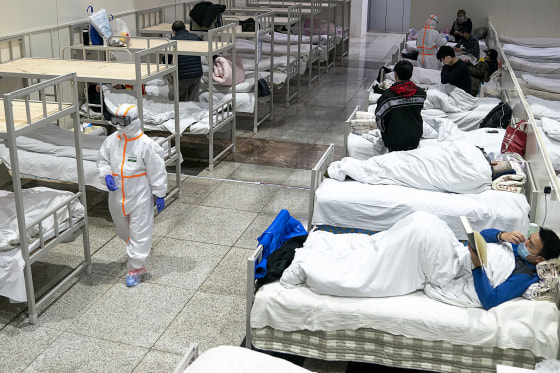A highly anticipated report published Friday offers insights into how the new coronavirus affects patients.
The report, published in the Journal of the American Medical Association or JAMA, details the cases of 138 patients with the virus in Wuhan, China, the epicenter of the outbreak. It's data that clinicians and public health officials worldwide have waited for as they seek to understand how the virus works.
All of the patients were hospitalized at Zhongnan Hospital of Wuhan University during January as the outbreak was spreading rapidly. More than a quarter developed complications and needed intensive care. Six patients died.
The risk for severe complications of the new coronavirus increases with age and for those with underlying health conditions, according to the report.
Fever appears to be a key symptom in how the virus manifests itself in patients.
Of the 138 patients:
- 99 percent had a fever
- 70 percent had fatigue
- 59 percent had a dry cough
- 39 percent had appetite loss
- 34 percent had body aches
- 10 percent or fewer had diarrhea, nausea and dizziness.
Coronaviruses, which cause respiratory infections, usually spread through the droplets that spray out when an infected person sneezes or coughs. This particular virus appears to have spread easily despite an apparent absence of sneezing, and may be a reason it circulated apparently undetected for a period of time.
"One reason for the rapid spread may be related to the atypical symptoms in the early state in some patients," the study authors wrote. That is, people may not have realized they were sick, because they didn't have the sneezing and congestion usually associated with colds.
Indeed, other reports show the disease is mild for most people. Chinese health authorities had provided data on 17,000 patients to the World Health Organization as of Friday.
Eighty-two percent of those cases were determined to be mild, the WHO said. Fifteen percent were more severe, and 3 percent were determined to be critical cases.
"That varies with age," Maria Van Kerkhove, technical lead for the WHO's Health Emergencies Program, said during a media briefing Friday. "The older you are, the higher the proportion of [severe] cases there are."
Full coverage of the coronavirus outbreak
The average age of the 138 hospitalized patients detailed in the JAMA report was 56 years. Nearly half had underlying health problems, such as high blood pressure, diabetes, heart disease or cancer.
Just because you're well on day one or two doesn't mean you'll necessarily be well on day four, five or six.
Patients who developed complications did so about five days after they first started having the symptoms.
"Just because you're well on day one or two doesn't mean you'll necessarily be well on day four, five or six," Dr. Anthony Fauci, director of the National Institute of Allergy and Infectious Diseases, said during an interview with the editor of JAMA, which was published by the journal.
Many of the patients got the infection in the hospital: 40 of the 138 are health care workers, and 17 of the 138 were already hospitalized for other reasons when they became infected by other patients.
In one case, a single patient is believed to have infected more than 10 health care workers.
A previous report of early cases suggested men may be more susceptible to the illness, because more men were reported to be sick, but the new data suggest cases are roughly equal between men and women.
"Infection in patients in the previous report was related to exposure associated with the Huanan Seafood Wholesale Market, and most of the affected patients were male workers," the study authors wrote. In other words, most of the first people thought to have been exposed to the virus in the market in Wuhan are men.
As of Friday, more than 31,000 confirmed cases and 677 deaths had been reported, mostly in China.
Follow NBC HEALTH on Twitter & Facebook.


